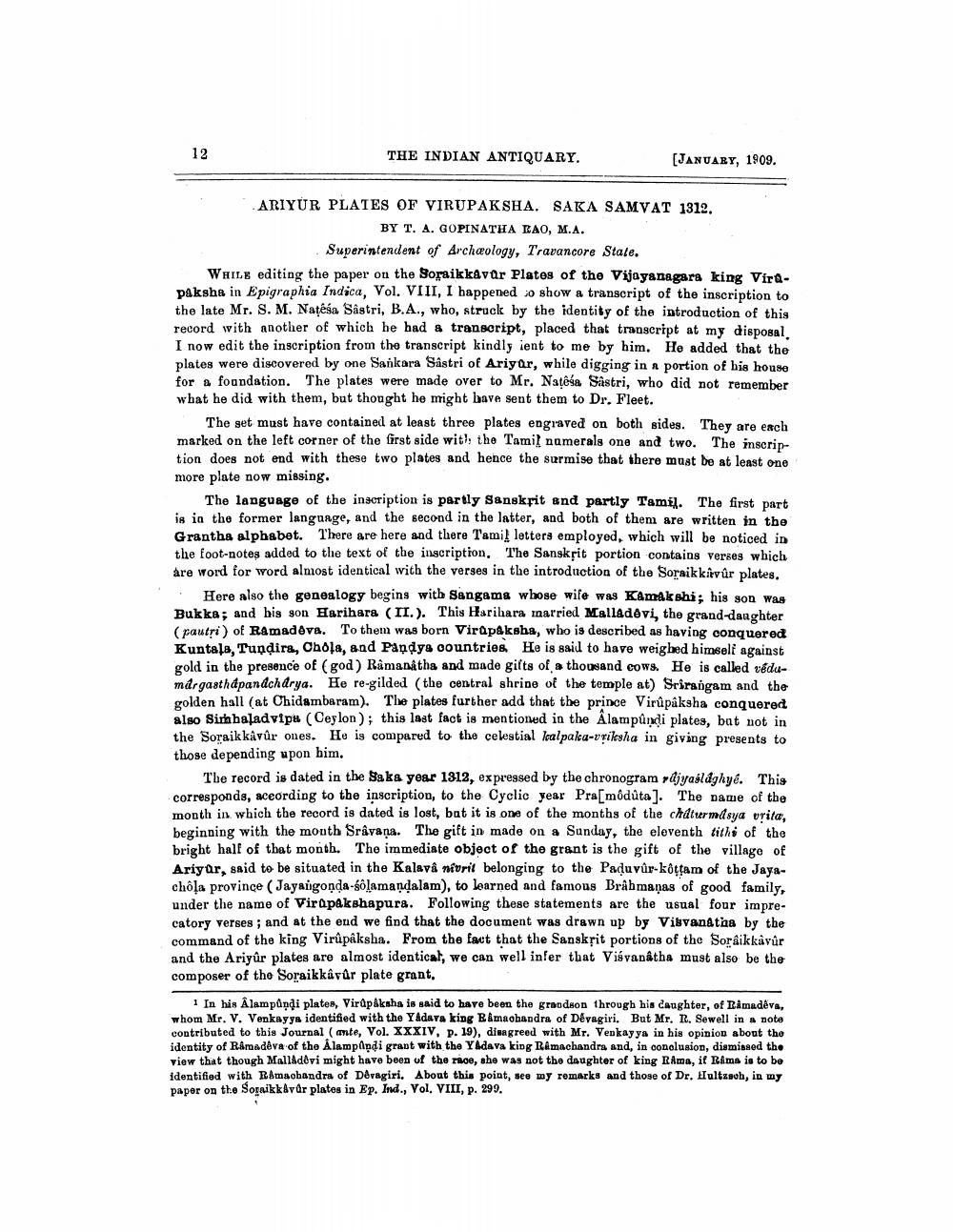________________
12
THE INDIAN ANTIQUARY.
[JANUARY, 1909.
ARIYUR PLATES OF VIRUPAKSHA. SAKA SAMVAT 1312. BY T. A. GOPINATHA KAO, M.A.
Superintendent of Archaeology, Travancore State.
WHILE editing the paper on the Soraikkavar Plates of the Vijayanagara king Virapaksha in Epigraphia Indica, Vol. VIII, I happened to show a transcript of the inscription to the late Mr. S. M. Natêsa Sâstri, B.A., who, struck by the identity of the introduction of this record with another of which he had a transcript, placed that transcript at my disposal, I now edit the inscription from the transcript kindly ient to me by him. He added that the plates were discovered by one Sankara Sâstri of Ariyar, while digging in a portion of his house for a foundation. The plates were made over to Mr. Natêía Sastri, who did not remember what he did with them, but thought he might have sent them to Dr. Fleet.
The set must have contained at least three plates engraved on both sides. marked on the left corner of the first side with the Tamil numerals one and two. tion does not end with these two plates and hence the surmise that there must more plate now missing.
They are each The inscripbe at least one
The language of the inscription is partly Sanskrit and partly Tamil. The first part is in the former language, and the second in the latter, and both of them are written in the Grantha alphabet. There are here and there Tamil letters employed, which will be noticed in the foot-notes added to the text of the inscription. The Sanskrit portion contains verses which are word for word almost identical with the verses in the introduction of the Soraikkâvûr plates.
Here also the genealogy begins with Sangama whose wife was Kamakshi; his son was Bukka; and his son Harihara (II.). This Harihara married Malladevi, the grand-daughter (pautri) of Ramadeva. To them was born Virupaksha, who is described as having conquered Kuntala, Tundira, Chola, and Pandys countries. He is said to have weighed himself against gold in the presence of (god) Ramanatha and made gifts of a thousand cows. He is called védumargasthapanacharya. He re-gilded (the central shrine of the temple at) Srirangam and the golden hall (at Chidambaram). The plates further add that the prince Virûpâksha conquered also Simhaladvipa (Ceylon); this last fact is mentioned in the Alampundi plates, but not in the Soraikkâvûr ones. He is compared to the celestial kalpaka-vriksha in giving presents to those depending upon him.
The record is dated in the Saka year 1312, expressed by the chronogram rajyaślághye. This corresponds, according to the inscription, to the Cyclic year Pra[môdûta]. The name of the month in which the record is dated is lost, but it is one of the months of the chaturmasya vṛita, beginning with the mouth Srâvana. The gift in made on a Sunday, the eleventh tiths of the bright half of that month. The immediate object of the grant is the gift of the village of Ariyûr, said to be situated in the Kalavâ nivrit belonging to the Paduvur-kôṭṭam of the Jayachôla province (Jayaugonda-solamandalam), to learned and famous Brahmanas of good family, under the name of Virupakshapura. Following these statements are the usual four imprecatory verses; and at the end we find that the document was drawn up by Visvanatha by the command of the king Virûpâksha. From the fact that the Sanskrit portions of the Sorâikkâvûr and the Ariyûr plates are almost identical, we can well infer that Viśvanâtha must also be the composer of the Soraikkâvûr plate grant.
1 In his Âlampuṇḍi plates, Virupaksha is said to have been the grandson through his daughter, of Ramadeva, whom Mr. V. Venkayya identified with the Yadava king Ramachandra of Devagiri. But Mr. R. Sewell in a note contributed to this Journal (ante, Vol. XXXIV, p. 19), disagreed with Mr. Venkayya in his opinion about the identity of Ramadêva of the Alampandi grant with the Yadava king Ramachandra and, in conclusion, dismissed the view that though Malladevi might have been of the race, she was not the daughter of king Rama, if Rama is to be identified with Ramachandra of Devagiri. About this point, see my remarks and those of Dr. Hultzsch, in my paper on the Sogaikkåvår plates in Ep. Ind., Vol. VIII, p. 299.




